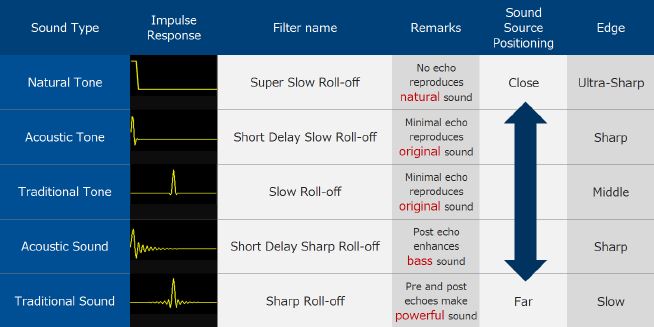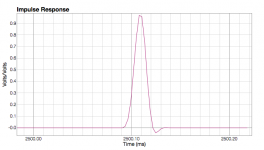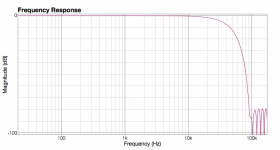Hi Andrew. Unfortunately, not enough time to make a serious listening and compare all these filters that Paul creates! So I just uploaded the 384_C130 that you suggested and compared it with the C960 I was previously listening. Well after some listening I found that something was a bit strange with the voices and the soundstage, so I checked again my setup. So I found that there was a very small difference in the toe-in of my speakers. After moving the speakers I can agree with what you say about the imaging and the focus. At least to my ears, the difference is there. So I agree with you that C384 is better than C960.
I also compared it with the C128_100, one of the best filters in my opinion, due to its naturalness, despite the fact that it is not so open and airy. And I think that I prefer C384 overall. So another great filter, maybe the best?!
Sorry about the avalanche of filters. 😉
These are variations on previous filters and were primarily to see what was gained/lost by swapping Nyquist filter for minimum phase.
It seems to me that simply maintaining the same length and roll-off results in a filter that isn't as pleasing as the linear phase "parent". I have a suspicion that the best results will come from maintaining a similar amount of post-ringing to the original filter, rather than just moving the combined ringing after the impulse.
I've been listening to tracks from Kudsi Erguner's "Taj Mahal" a bit over the past 3-4 days.
http://www.enjoythemusic.com/magazine/globalcaravan/0202/erguner.htm
Last edited:
Good to hear my thoughts on Paul's latest filter echoed. Interesting to hear you too found a small adjustment with speaker positioning makes a significant difference to soundstage and focus. Paul's on-going work with input and feedback from others is turing this latest edition to the diy community into something quite special, I suggest. Thanks to all!!
Listening to the latest filters now.
Its getting hard explaining clear differences in them.
But we have a good handful of great sounding filters.
Right now I am enjoying 1021filt_1008MP which have some really nice sound to relative simple acoustic music.
Its getting hard explaining clear differences in them.
But we have a good handful of great sounding filters.
Right now I am enjoying 1021filt_1008MP which have some really nice sound to relative simple acoustic music.
Over the past few days testing with the HD800, I actually find C384 really upfront like the stock filter. Not to my taste... and not exactly possible to adjust "speaker position" for headphones.
Like Bambadoo, the 1008MP is a nicer listen for me... similarly I can't pinpoint exact differences between the MP and NQ filters.
Like Bambadoo, the 1008MP is a nicer listen for me... similarly I can't pinpoint exact differences between the MP and NQ filters.
Since I hadn't tested the 1008MP, I've just made a brief listening test. I can clearly hear the difference between C384 and C1008. I am still in fond of C384 since it is much better in air, separation, and focus. So, at least for me C384 is the new benchmark... 🙂
By the way I find C1008 more upfront than C384....
By the way I find C1008 more upfront than C384....
Since I hadn't tested the 1008MP, I've just made a brief listening test. I can clearly hear the difference between C384 and C1008. I am still in fond of C384 since it is much better in air, separation, and focus. So, at least for me C384 is the new benchmark... 🙂
By the way I find C1008 more upfront than C384....
Sorry, the filter is 1021filt_384_C130_MP, not C384.
I am sorry if I have missed this but does anyone know if the DAM uses the serial or parallel method as described in http://www.abvolt.com/compdsp/presentations/Lyons/Lyons-Precise FIR Coefficients.pdf for improving the precision of co-efficients?
Paul
1021filt_384_C130_MP - definitely a step in the right direction. This filter fits into my sense of good balanced sound. Previous filters exposed the vocals too much. Converter sounded too insistently. Sorry for my English. I hope that you have understood what I mean. It's hard to write about nuances when you do not speak the language well. Translated by Google ;-)
1021filt_384_C130_MP - definitely a step in the right direction. This filter fits into my sense of good balanced sound. Previous filters exposed the vocals too much. Converter sounded too insistently. Sorry for my English. I hope that you have understood what I mean. It's hard to write about nuances when you do not speak the language well. Translated by Google ;-)
Sorry, the filter is 1021filt_384_C130_MP, not C384.
The naming is a bit messy I'm afraid.
Hopefully this won't need to be changed, here on in.
384 = number of taps
C = Chebyshev Window
130dB = Window side lobe attenuation setting.
MP = minimum phase or LP = linear phase
It didn't make sense to use C384 etc as the elements of the name aren't directly related, whereas C130 is the complete window specification. It's a bit tricky to name the filters without names getting excessively long, but at least it's a bit more meaningful (to me at least).
Paul
1021filt_384_C130_MP - definitely a step in the right direction. This filter fits into my sense of good balanced sound. Previous filters exposed the vocals too much. Converter sounded too insistently. Sorry for my English. I hope that you have understood what I mean. It's hard to write about nuances when you do not speak the language well. Translated by Google ;-)
I know what you mean. Vocals seem to move in relation to the rest of the mix depending on the filter, and with some filters they can sound too forward compared to the rest of the mix.
I've been listening for the past day or so to the 384_C130_MP, rather than swapping back and forth, and having a break from a diet of test tracks.
glt's site has some information about AKM filters and I noticed one that was minimum phase with virtually no post ringing..

The observations on the AKM chart seem reasonably close to what I've noticed with the different types of filters. Sharp roll-off is definitely a more beefy sound - one I think a lot of people are familiar with.
Anyway I thought might be interesting to do a super short, super slow filter so threw this together. It's 16 taps long so, twice the the length of a NOS filter but 1/8 the length of the C128....
It doesn't attenuate until 100kHz but should be ok with class-d amps with any luck. Sounds fine on mine.
Attachments
Last edited:
Up to now the DAM uses the direct implementation. It looks as if the "parallel method" is the same, as what I called "partial floats" and Soekris answered here that it would be doable. But then you can not use the preprogrammed FIR units of the FPGA but have to program them yourself.I am sorry if I have missed this but does anyone know if the DAM uses the serial or parallel method as described in http://www.abvolt.com/compdsp/presentations/Lyons/Lyons-Precise FIR Coefficients.pdf for improving the precision of co-efficients?
Moreover if you do not use one fixed filter but want to load them, you need extra bits which determine the amount of shift, which alters a bit the "same amount of bits" picture of the slides.
Since I hadn't tested the 1008MP, I've just made a brief listening test. I can clearly hear the difference between C384 and C1008. I am still in fond of C384 since it is much better in air, separation, and focus. So, at least for me C384 is the new benchmark... 🙂
By the way I find C1008 more upfront than C384....
Maybe upfront is the wrong term. If you set the volume such that the vocals are the about the same volume between the filters (I set C1008 slightly softer than C384), the rest of the track is less in the same "plane" with C1008 vs C384. It seems like everything is the same distance away from me for C384, whereas for C1008 I get more separation in "soundstage depth" from vocal to other instruments... this is most evident in like ballads.
So with C384, if I turn up the volume I get the sense that everything (and I mean everything) is right in my face which was the perception that I got with the stock filters. With 1008, the music is enveloping but not everything is right in your face... I agree that instruments are closer to you than C384... but the vocals are still the same distance away.
Again, I should mention that this is with headphones (In my experience so far, testing with headphones tend to fit well with speaker impressions, but the same isn't always true for speaker to headphones). And short of me being there in the recording environment, I can't say which of the interpretation is more "authentic" or "correct."
FWIW, I can gladly live with almost all the latest generation of filters... including C960 and it's sibilant nature (personal opinion there, too).
Since getting the DAM and discovering Paul's filters I've really dug through all my old files including really crappy 128kbps - 320kbps mp3s and I'm quite surprised that most of them sound decent to good.
Last edited:
Since getting the DAM and discovering Paul's filters I've really dug through all my old files including really crappy 128kbps - 320kbps mp3s and I'm quite surprised that most of them sound decent to good.
Yep, that is something that I have also noticed and I was surprised. Yesterday I was just immersed into music, without concering about checking details, etc. 384 at least for me creates a huge 3D stage, with a height up to the ceiling, with a very nice focus and separation of instruments and vocals. First time I am hearing my system reproducing so well. 🙂 On the other hand, C1008 creates a more fuzzy imaging, where instruments have more volume than expected (e.g. for a classical guitar it is easier to locate with closed eyes the exact point that the fingers hit the strings with 384 rather with 1008).
Another good thing regarding the new filters.... I turn the volume of my amplifier all up, 300W and I hear nothing irritating to my ear! And also there is energy. Tapping the guitar can really be scary! 🙂
Last edited:
Another good thing regarding the new filters.... I turn the volume of my amplifier all up, 300W and I hear nothing irritating to my ear!
Same here... just that I do get something irritating... nagging from the significant other 🙁
Anyway I thought might be interesting to do a super short, super slow filter so threw this together. It's 16 taps long so, twice the the length of a NOS filter but 1/8 the length of the C128....
It doesn't attenuate until 100kHz but should be ok with class-d amps with any luck. Sounds fine on mine.
Can you post impulse resp on logarithmic scale? Thanks.
Dumb question from me, but if a filter has less gain, like NewNOS or C16, does it mean i can turn the pot over ''0'' position before clipping? (As i understand the pot ''0'' position is not 0dBFS)
It looks like the range goes to +15 while tracking in TeraTerm window.
It looks like the range goes to +15 while tracking in TeraTerm window.
More listening impressions:
-NQ C960_140 gets fatiguing after a while (20min), it is not sibilant like a typical Sabre dac, but it has an edge in somewhere 10kHz region, some gear i have listened have measurable problems in that area, not a simple fr spike, but time domain saturation or ringing that remin me the same edginess. Like super snappy 😉 I had confirmation when my gf listened to these filters and instantly disliked the c960, women have a bit more sensitive hearing in upper frequencies. Ofc she had no idea which filter does what or which i personally liked. Otherwise the C960 is technically more adapt in treble than NQ_C128_100 to my ears.
C960 is also brighter, i can't say if more neutral or not.
-ct1014_60 is surprisingly good, great dynamics, similar to the Nyquist filters, but a bit closed-in sounding.
-384_C130_MP is among the best i have tried. Tonally similar to Nq C128, maybe less dark. It has a bit more beef down low, notes are thicker in a good way. Bass feels a hair heavier. Not quite as natural sounding as Nq C128.
-16_C110 is nice open sounding, reminiscent of nos. Tonally tilted to bright side of things. Bass is too light footed, doesn't have proper impact. I feel somewhat the same about NOS actually, but to lesser degree.
I have no clue why, but i trust my ears as there are significant differences in tonal balance and bass presentation. Few dB tilt from 10kHz up won't have that effect.
Maybe some width of impulse response works in the Dam favor? Compensates something in the design, like quantization error or smth? Makes notes thicker sounding?
-NQ C960_140 gets fatiguing after a while (20min), it is not sibilant like a typical Sabre dac, but it has an edge in somewhere 10kHz region, some gear i have listened have measurable problems in that area, not a simple fr spike, but time domain saturation or ringing that remin me the same edginess. Like super snappy 😉 I had confirmation when my gf listened to these filters and instantly disliked the c960, women have a bit more sensitive hearing in upper frequencies. Ofc she had no idea which filter does what or which i personally liked. Otherwise the C960 is technically more adapt in treble than NQ_C128_100 to my ears.
C960 is also brighter, i can't say if more neutral or not.
-ct1014_60 is surprisingly good, great dynamics, similar to the Nyquist filters, but a bit closed-in sounding.
-384_C130_MP is among the best i have tried. Tonally similar to Nq C128, maybe less dark. It has a bit more beef down low, notes are thicker in a good way. Bass feels a hair heavier. Not quite as natural sounding as Nq C128.
-16_C110 is nice open sounding, reminiscent of nos. Tonally tilted to bright side of things. Bass is too light footed, doesn't have proper impact. I feel somewhat the same about NOS actually, but to lesser degree.
I have no clue why, but i trust my ears as there are significant differences in tonal balance and bass presentation. Few dB tilt from 10kHz up won't have that effect.
Maybe some width of impulse response works in the Dam favor? Compensates something in the design, like quantization error or smth? Makes notes thicker sounding?
Last edited:
Dumb question from me, but if a filter has less gain, like NewNOS or C16, does it mean i can turn the pot over ''0'' position before clipping? (As i understand the pot ''0'' position is not 0dBFS)
It looks like the range goes to +15 while tracking in TeraTerm window.
In most cases no. The filters still have the same amount of energy, but it is spread across a wider frequency range due to the HF images above nyquist. The output sounds quieter but will tend to clip if you increase the gain.
- Home
- Source & Line
- Digital Line Level
- Filter brewing for the Soekris R2R

